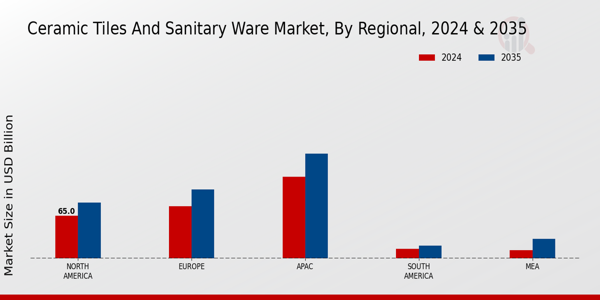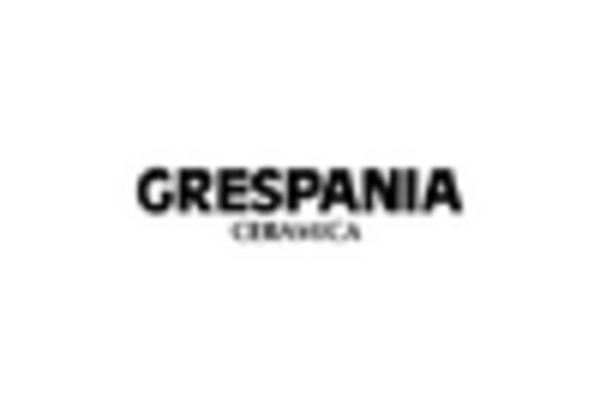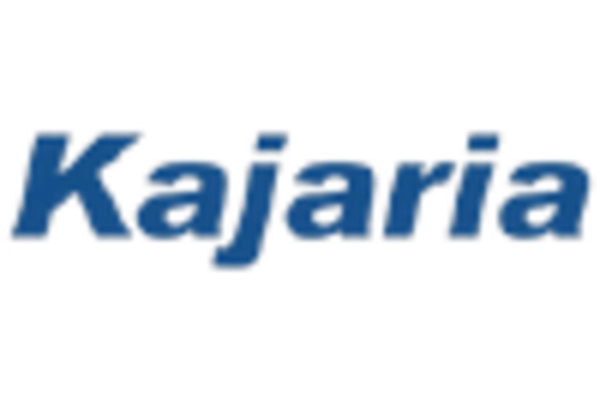Rising Urbanization
The ongoing trend of urbanization appears to be a pivotal driver for the Ceramic Tiles and Sanitary Ware Market. As populations migrate towards urban centers, the demand for residential and commercial spaces escalates. This surge in construction activities necessitates the use of ceramic tiles and sanitary ware, which are favored for their durability and aesthetic appeal. According to recent data, urban areas are projected to house approximately 68 percent of the world's population by 2050, thereby amplifying the need for high-quality building materials. Consequently, manufacturers in the Ceramic Tiles and Sanitary Ware Market are likely to experience increased demand, prompting innovations in product offerings to cater to urban consumers' preferences.
Sustainability Initiatives
The increasing emphasis on sustainability is reshaping the Ceramic Tiles and Sanitary Ware Market. Consumers are becoming more environmentally conscious, leading to a preference for eco-friendly products. Manufacturers are responding by adopting sustainable practices, such as using recycled materials and reducing waste during production. Recent studies indicate that the market for sustainable building materials is expected to grow significantly, with a projected increase of 10 percent annually. This shift towards sustainability not only aligns with consumer values but also enhances brand reputation. As a result, companies within the Ceramic Tiles and Sanitary Ware Market are likely to invest in sustainable technologies and materials, positioning themselves favorably in a competitive landscape.
Technological Advancements
Technological advancements are playing a crucial role in transforming the Ceramic Tiles and Sanitary Ware Market. Innovations in manufacturing processes, such as digital printing and advanced glazing techniques, are enabling the production of high-quality, customized products. These technologies not only enhance the aesthetic appeal of ceramic tiles but also improve their durability and functionality. Market analysis indicates that the adoption of smart technologies in sanitary ware, such as touchless faucets and water-saving toilets, is on the rise. This trend reflects a growing consumer demand for convenience and efficiency in bathroom fixtures. As a result, companies in the Ceramic Tiles and Sanitary Ware Market are likely to invest in research and development to leverage these technological advancements, thereby gaining a competitive edge.
Growing Construction Sector
The expansion of the construction sector serves as a significant catalyst for the Ceramic Tiles and Sanitary Ware Market. With increasing investments in infrastructure development, particularly in emerging economies, the demand for ceramic tiles and sanitary ware is expected to rise. Recent statistics indicate that the construction industry is anticipated to grow at a compound annual growth rate of around 5.5 percent over the next five years. This growth is likely to be driven by both residential and commercial projects, where ceramic tiles are preferred for their versatility and sanitary ware for their essential role in modern bathrooms. As a result, stakeholders in the Ceramic Tiles and Sanitary Ware Market are poised to benefit from this upward trajectory.
Consumer Preference for Aesthetics
The evolving consumer preference for aesthetics and design in home interiors is increasingly influencing the Ceramic Tiles and Sanitary Ware Market. Homeowners and designers are now prioritizing visually appealing products that enhance the overall ambiance of living spaces. This trend is reflected in the rising demand for decorative ceramic tiles and stylish sanitary ware, which are often seen as essential elements in contemporary interior design. Market data suggests that the demand for designer tiles has surged, with a notable increase in sales of patterned and textured options. Consequently, manufacturers are compelled to innovate and diversify their product lines to meet the aesthetic aspirations of consumers, thereby driving growth in the Ceramic Tiles and Sanitary Ware Market.


















Leave a Comment